
As you celebrate National Public Lands Day, it’s a wonderful time to think about transforming your outdoor spaces into beautiful spots inspired by America’s stunning national parks. By adding native plants, peaceful water features, and friendly gardens for pollinators, you can not only improve the look of your yard but also help the environment. With these 20 exciting landscaping ideas, you can create a welcoming space that mirrors the beauty of nature’s wonders. Are you excited to learn how your own yard can reflect the magic of national parks?
Get ready to dive into some fun ways to make your yard beautiful and friendly to nature! From planting local flowers to adding small ponds, you can create a magic garden that attracts butterflies and birds. Let’s explore some amazing ideas that will turn your outdoor space into a vibrant park-like retreat right at home!
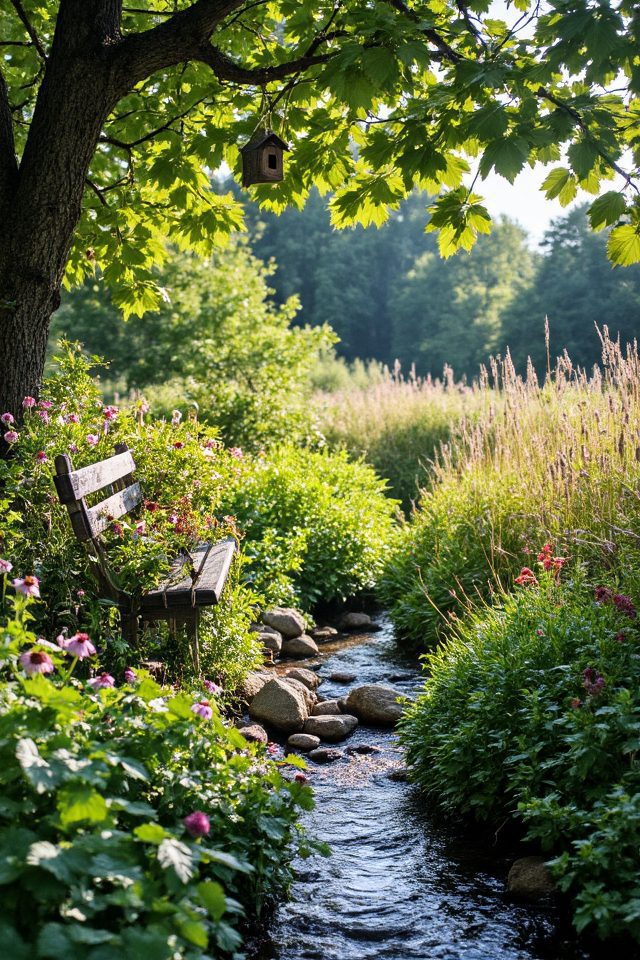
Embracing native plants in your garden not only enhances its beauty but also promotes biodiversity and sustainability.
These plants are well-adapted to your local climate and soil conditions, requiring minimal water and maintenance. By incorporating varieties native to your region, you create a resilient landscape that attracts local wildlife, such as birds and pollinators.
This low-maintenance approach not only saves time and resources but also fosters a connection to the natural ecosystem, echoing the charm of America’s expansive parks.
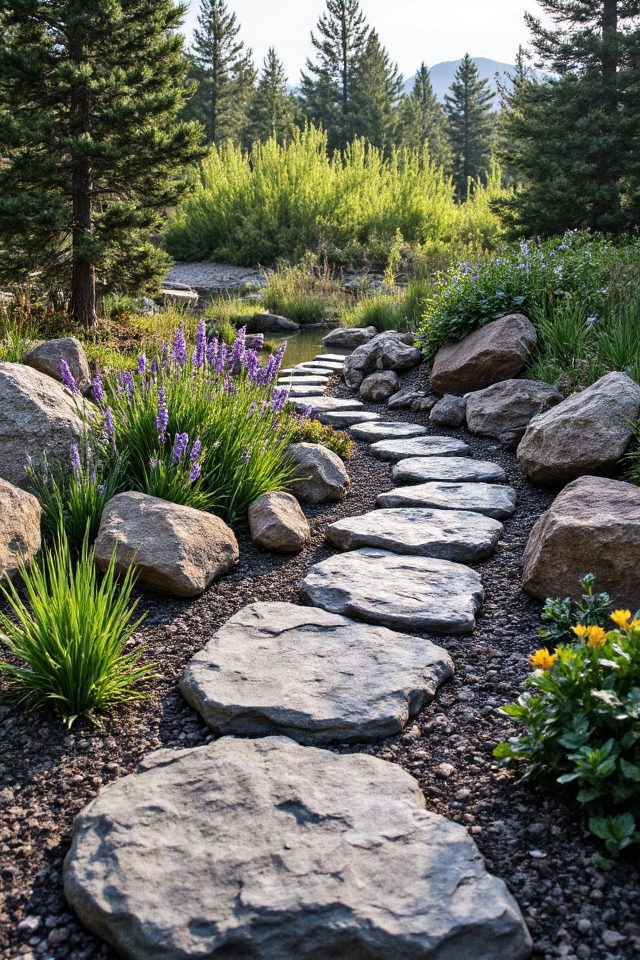
Transform your yard into a serene Rocky Mountain retreat by incorporating natural stone pathways that evoke the beauty of these majestic landscapes.
Start by selecting various sizes and shapes of stones to create a winding trail that mimics the organic flow of nature. Surround the pathway with native plants and grasses to enhance the rugged aesthetic.
Add rustic accents like boulders or small water features to complete the tranquil, mountainous ambiance right in your outdoor space.
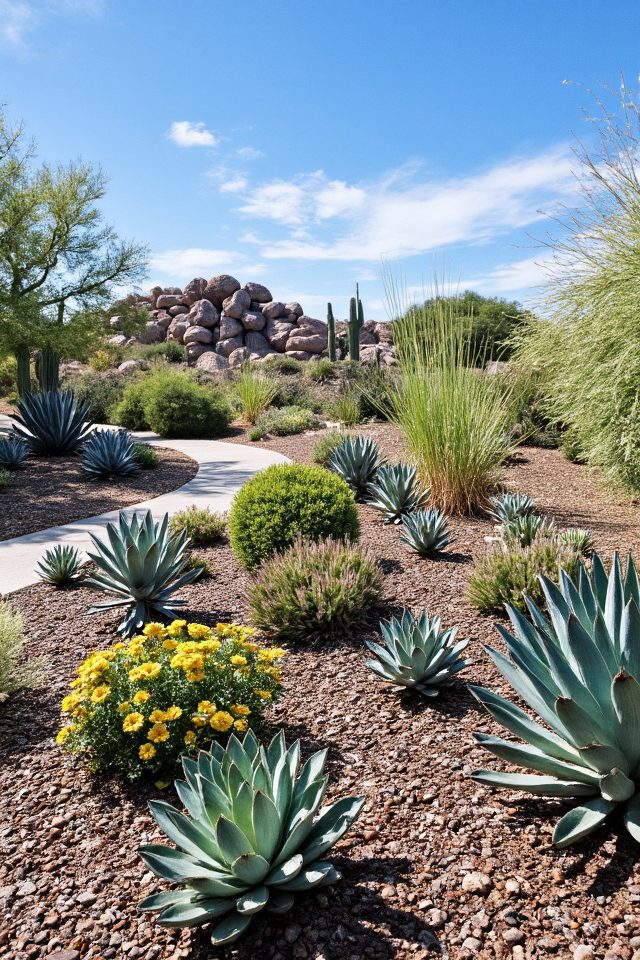
Designing a desert-inspired xeriscape focuses on creating a vibrant landscape that conserves water while showcasing drought-resistant plants. Incorporate native species like succulents, agaves, and ornamental grasses to enhance biodiversity.
Use gravel or mulch to reduce evaporation and consider incorporating decorative hardscapes like rock features or pathways.
Thoughtfully group plants with similar water needs and implement a drip irrigation system for efficient watering.
This sustainable approach not only saves water but also reflects the beauty of arid environments.
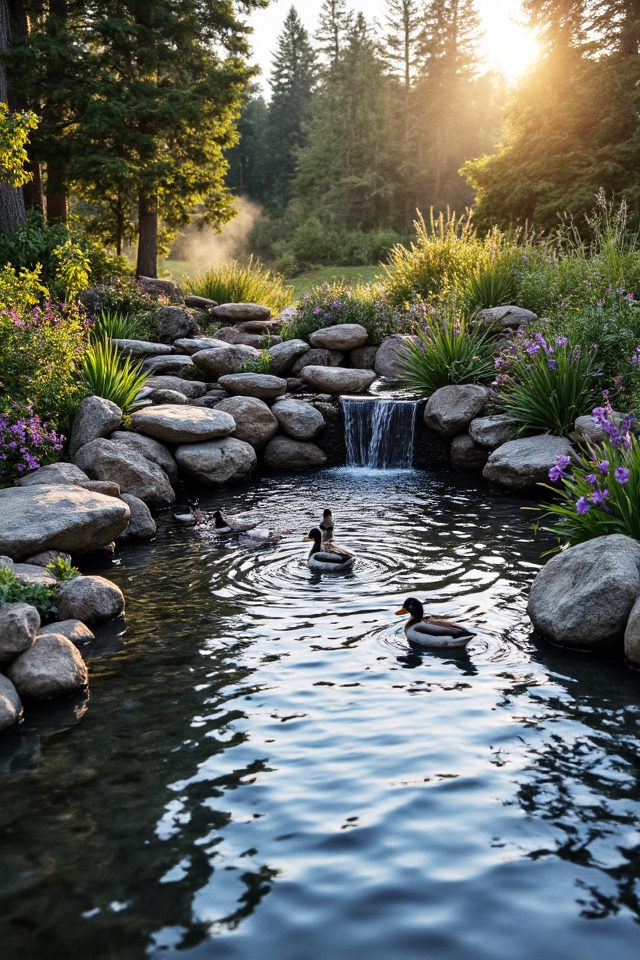
A tranquil water feature can bring the serene beauty of national park lakes right into your backyard.
Consider creating a pond or a small stream that mimics the gentle flow and stillness of these natural waters. Incorporate native plants around the edges, add smooth rocks, and even install a small waterfall for soothing sounds.
This won’t only create a peaceful retreat but also attract local wildlife, enhancing the natural ambiance of your space.
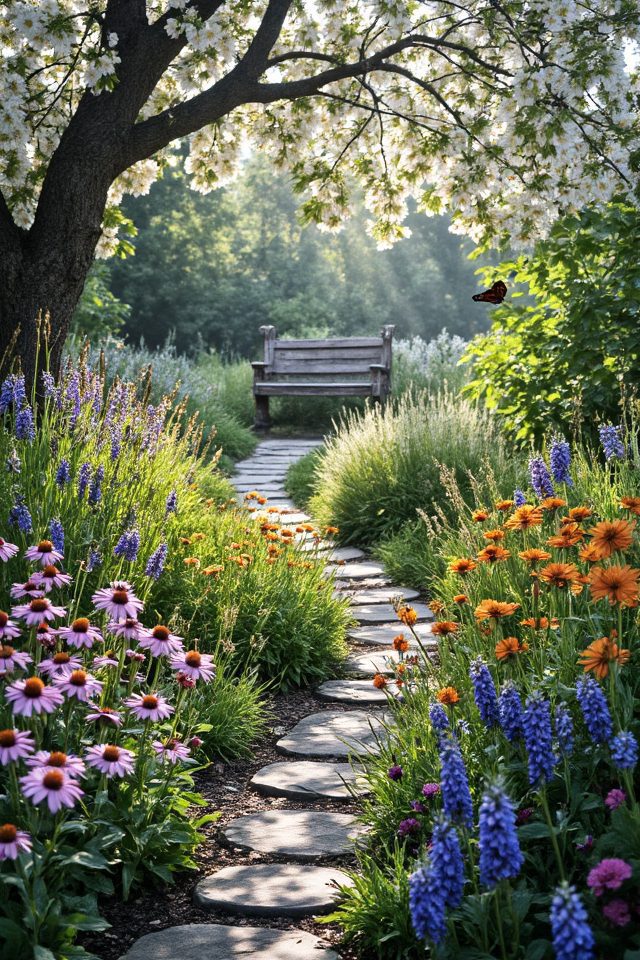
Incorporating pollinator gardens into your landscaping not only enhances the beauty of your space but also supports the crucial ecosystems that rely on bees and butterflies.
By selecting native plants rich in nectar and pollen, such as coneflowers, milkweed, and aster, you create a welcoming habitat for these essential pollinators.
Adding features like water sources and shelter increases habitat diversity, making your garden a vibrant sanctuary that contributes positively to the environment.
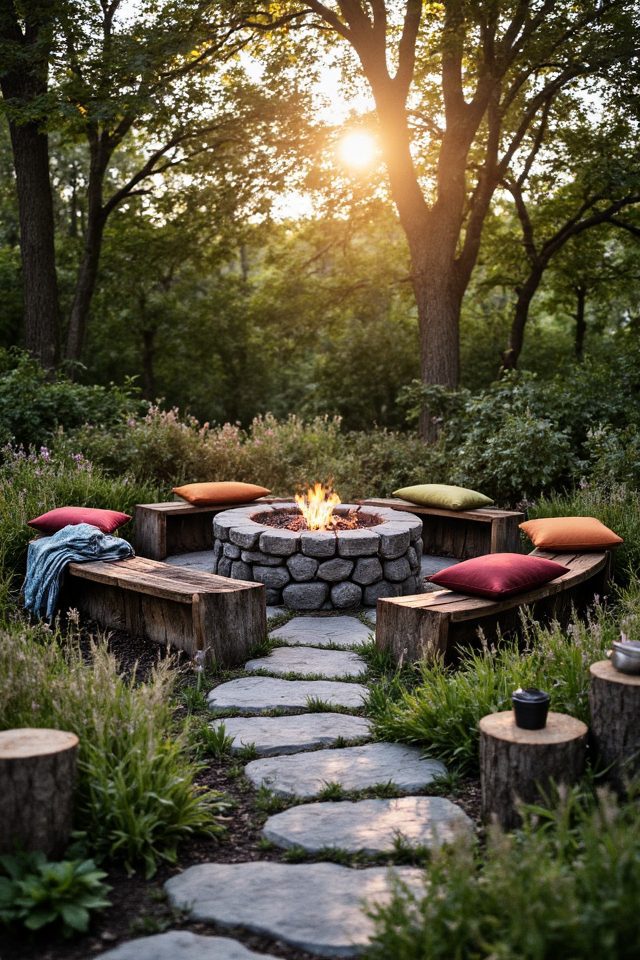
Transform your outdoor space into a cozy retreat with a fire pit surrounded by rustic seating inspired by America’s parks.
Utilize natural materials like reclaimed wood for benches and log stools to create an inviting atmosphere. Enhance the comfort with plush cushions and throw blankets.
Incorporate native plants and stone pathways to seamlessly blend your fire pit area into the landscape.
This setting not only provides warmth but also fosters a sense of community and connection with nature.
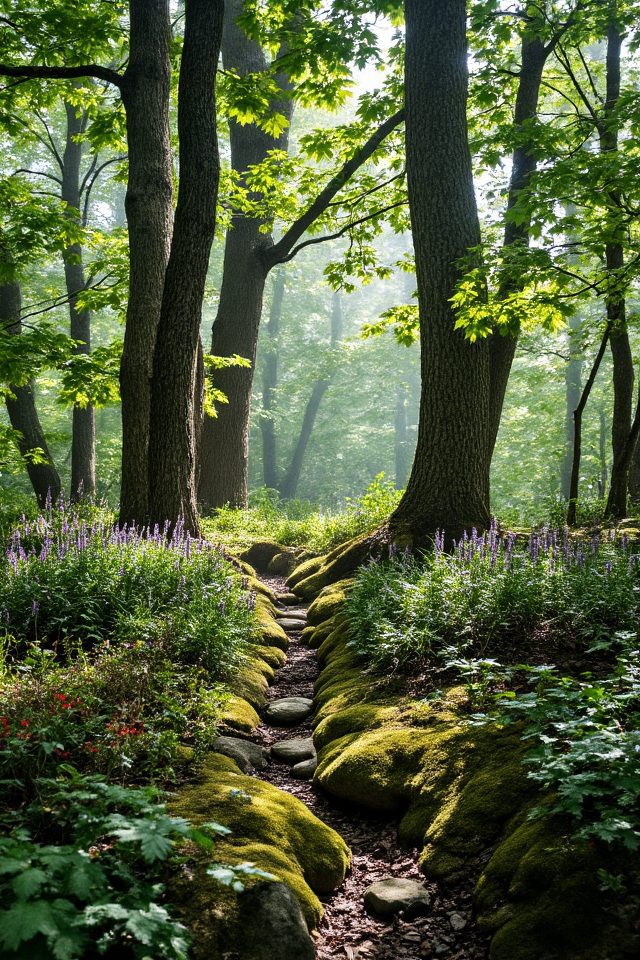
Creating a miniature forest in your backyard can bring a touch of nature’s tranquility right to your home.
Choose a diverse array of tree species, such as maples, oaks, and pines, to mimic the variety found in America’s national parks. Incorporate layered planting for depth, and consider adding understory plants like ferns and shrubs for added interest.
With proper spacing to allow each tree to grow, you’ll cultivate a lush, inviting retreat that showcases biodiversity.
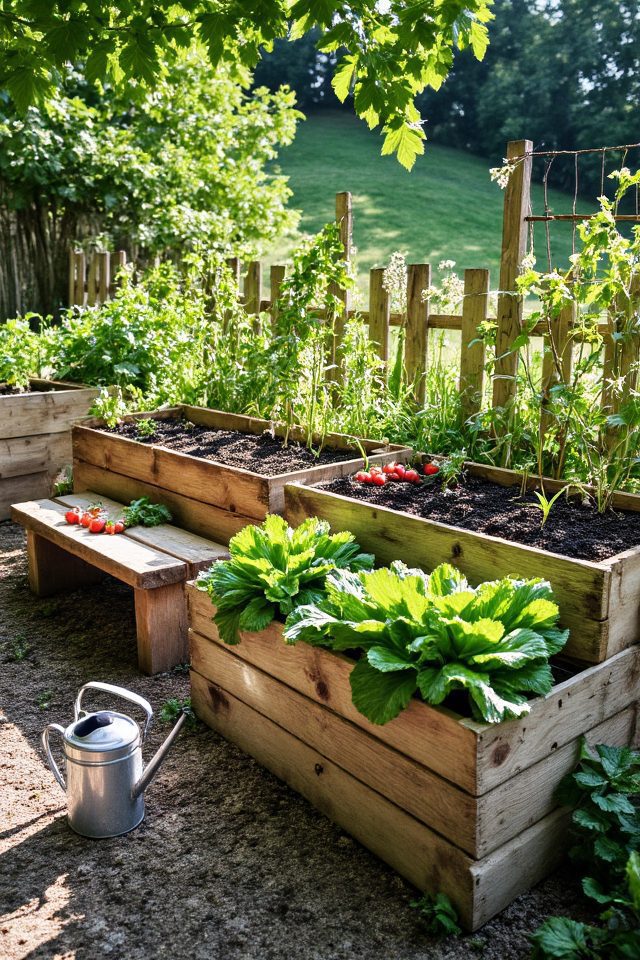
Raised garden beds are an excellent way to cultivate vegetables with ease and efficiency. By elevating the soil, these beds improve drainage and provide better access for gardening tasks, reducing back strain.
Inspired by the beautiful park landscapes across America, constructing raised beds can be both functional and aesthetically pleasing. Use untreated wood or recycled materials to create a rustic feel, and fill them with nutrient-rich soil to guarantee a bountiful harvest.
Adding trellises or decorative borders can enhance the visual appeal while maintaining practicality.
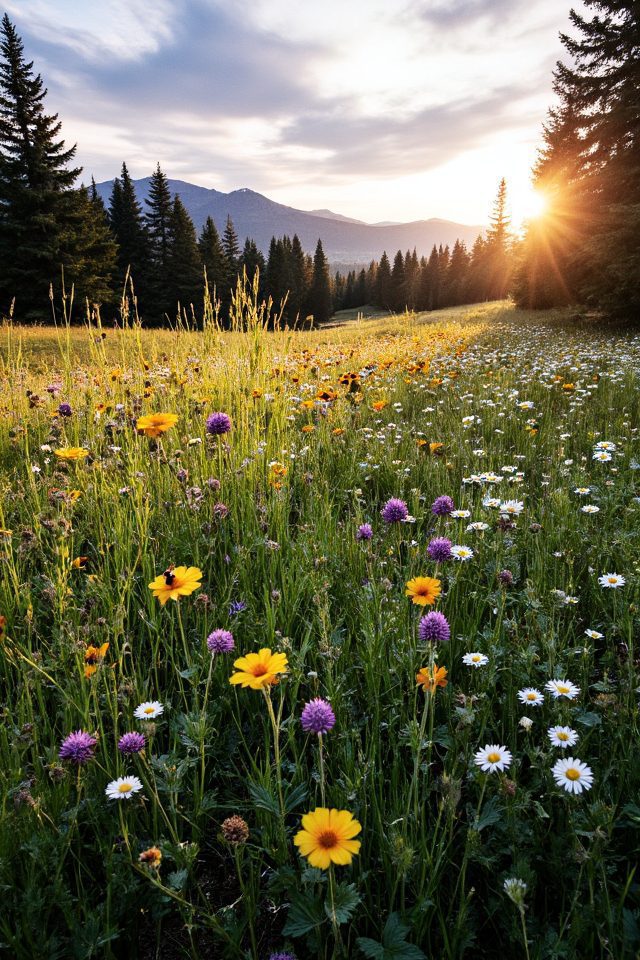
Colorful wildflower meadows can transform any landscape into a vibrant, dynamic space reminiscent of America’s national parks.
By selecting a diverse array of native wildflowers, homeowners can create a stunning tapestry of colors that attracts butterflies, bees, and other beneficial pollinators.
These meadows not only provide visual appeal but also promote biodiversity and require less maintenance than traditional lawns.
Incorporating wildflower meadows into your yard can enhance its ecological value while celebrating the beauty of nature.
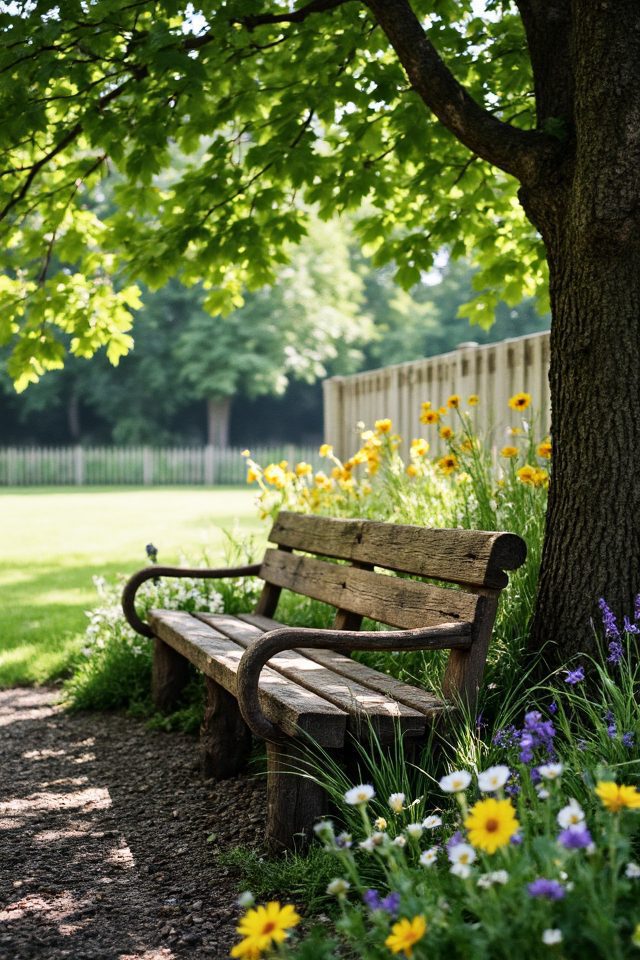
Creating a rustic log bench can transform your backyard into a cozy, park-like gathering space. Utilizing fallen trees or reclaimed wood, craft a sturdy bench that blends seamlessly with natural surroundings.
Incorporate simple designs, like wide armrests and a contoured seat, for comfort. Position the bench beneath a shady tree or near a flower garden, inviting family and friends to sit, relax, and enjoy the beauty of nature right at home.
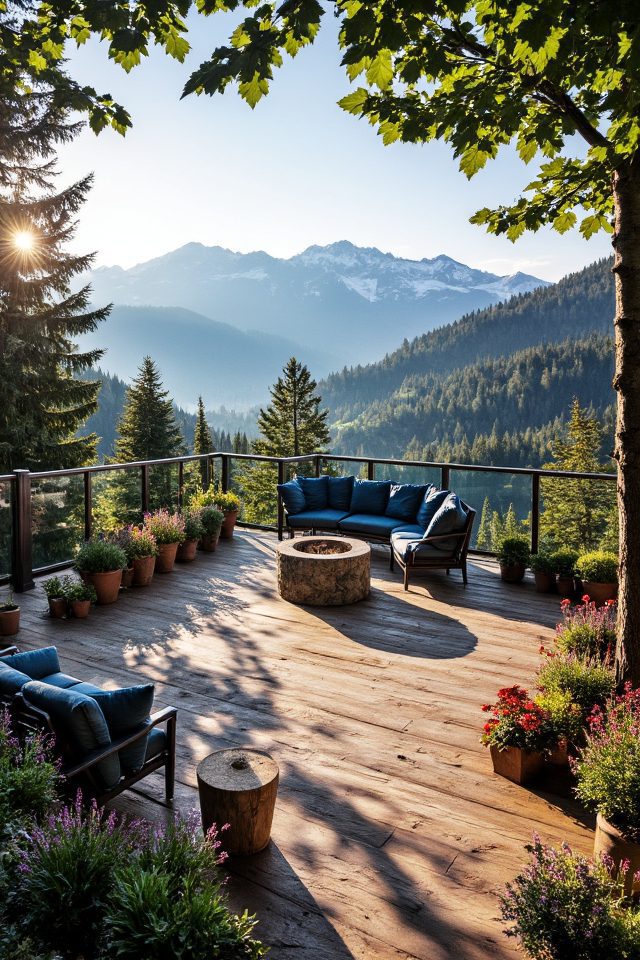
Designing a mountain view-inspired elevated deck can transform your outdoor space into a serene retreat.
Utilize natural materials like wood and stone to blend harmoniously with the landscape. Incorporate railings made of glass for unobstructed views, and arrange comfortable seating with cozy cushions to invite relaxation.
Adding potted plants and native flora can enhance the natural feel while creating a welcoming atmosphere. Strategically position the deck to capture sunrise or sunset for breathtaking moments.

Incorporating hardscaping with natural stone patios can transform your outdoor space into a serene retreat reminiscent of America’s picturesque parks.
Choose locally-sourced stones to create stunning patterns that blend with the natural landscape. These durable surfaces provide an ideal foundation for seating areas, fire pits, or outdoor dining, fostering relaxation and communal gatherings.
Additionally, the earthy tones and textures of natural stone can enhance the beauty of your garden, making it a personal oasis.
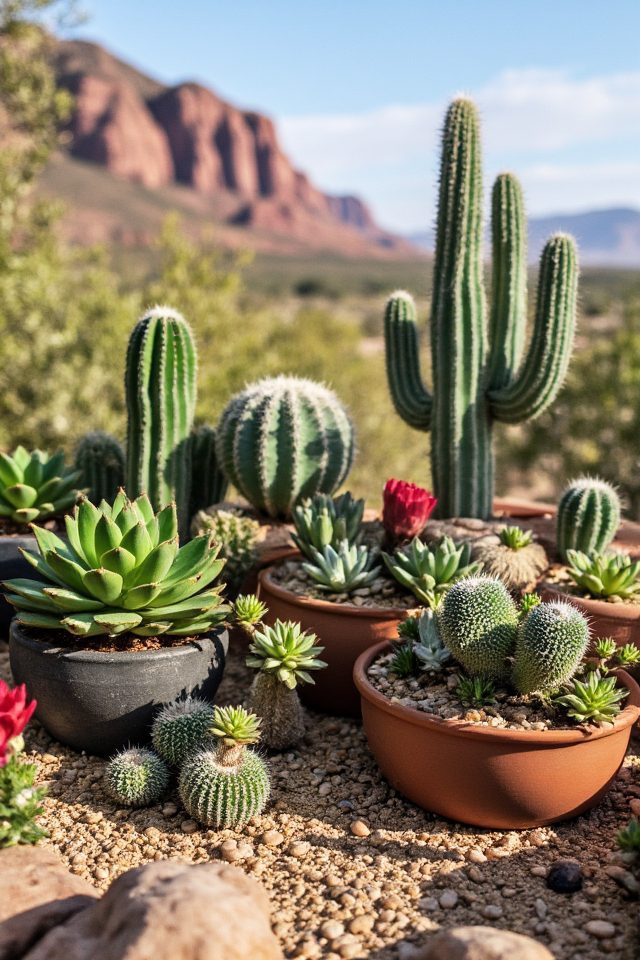
Transform your outdoor space with succulent and cactus arrangements that echo the beauty of America’s desert landscapes.
These drought-resistant plants offer vibrant, varied textures and colors, evoking the unique charm of arid environments. Grouping these hardy specimens in creative ways—such as in decorative pots, raised beds, or terrariums—can create striking focal points.
Add gravel or sand as a natural mulch to further mimic the desert floor and enhance the overall aesthetic.
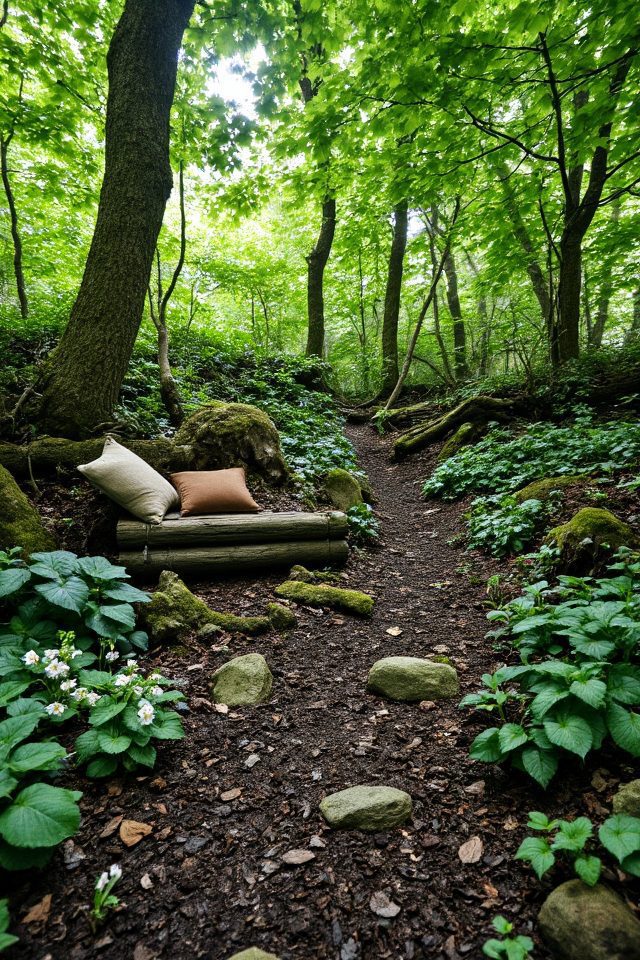
Transform your outdoor space into a serene woodland retreat by incorporating shade-loving plants that evoke the tranquility of America’s national parks.
Consider ferns, hostas, and astilbes to create lush layers of greenery. Add flowering plants like bleeding hearts or trilliums for pops of color.
Incorporate natural elements such as logs and stones to enhance the rustic feel, and don’t forget to include comfortable seating to enjoy your peaceful escape in nature’s embrace.
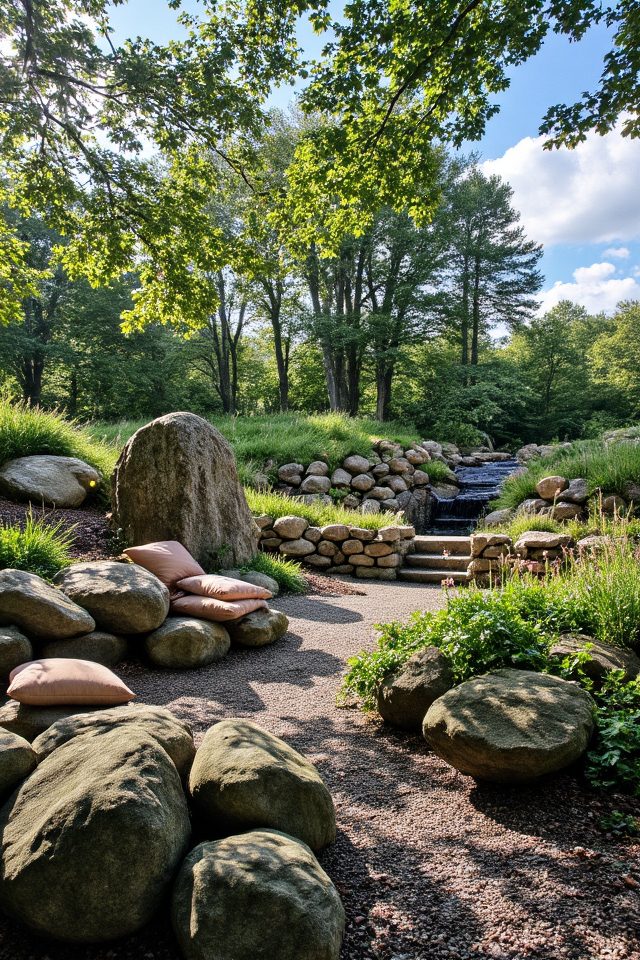
Incorporating natural boulders into your landscape design can create both decorative and functional elements inspired by America’s parks.
These stunning stones can serve as focal points, adding texture and visual interest to gardens and yards. They can also be used to create seating areas, borders for flower beds, or even retaining walls, all while blending seamlessly with the surrounding environment.
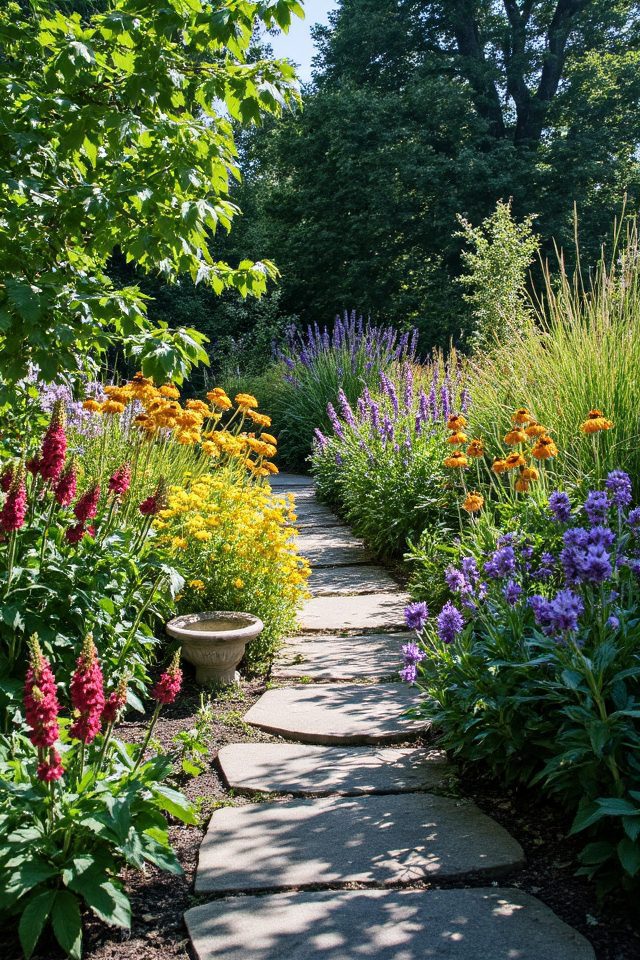
Creating a pollinator pathway with nectar-rich flowers is a wonderful way to support local ecosystems while beautifying your landscape.
Begin by selecting a variety of native plants that bloom at different times throughout the growing season, ensuring a constant food source for bees, butterflies, and other pollinators.
Incorporate a mix of colors and textures, and consider adding elements like stone pathways or water features to enhance the habitat.
This not only aids in pollinator health but also fosters a vibrant, dynamic garden space.
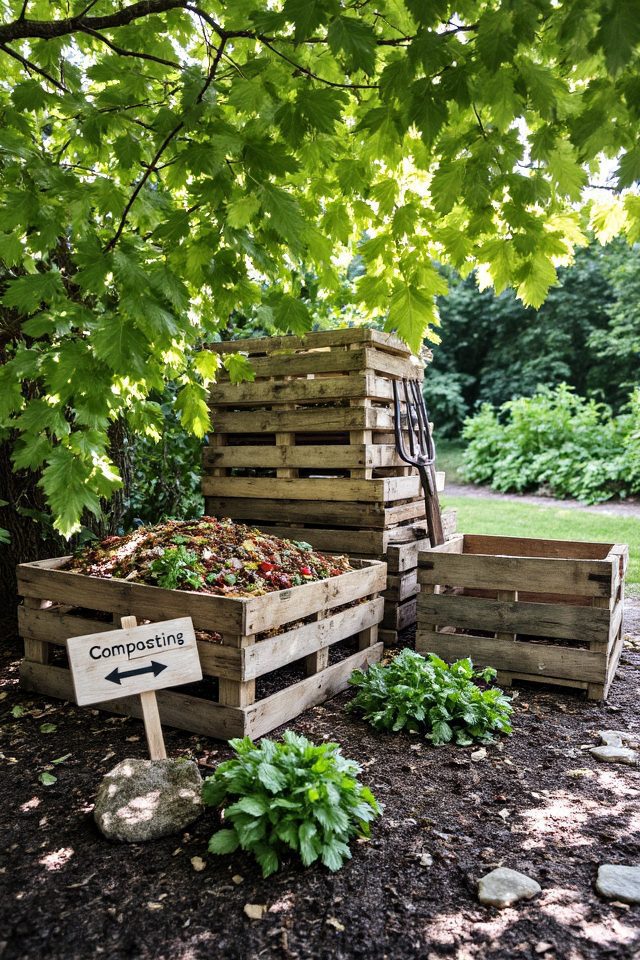
Creating an eco-friendly composting area is a fantastic way to promote sustainability in your landscape while honoring the natural beauty of America’s parks.
Choose a designated space, preferably shaded, to build a compost bin made from recycled materials. Layer organic waste such as kitchen scraps and yard trimmings, ensuring proper aeration for decomposition.
Incorporate native plants and pollinators nearby to enhance biodiversity. This not only reduces waste but enriches your garden soil, creating a thriving ecosystem.
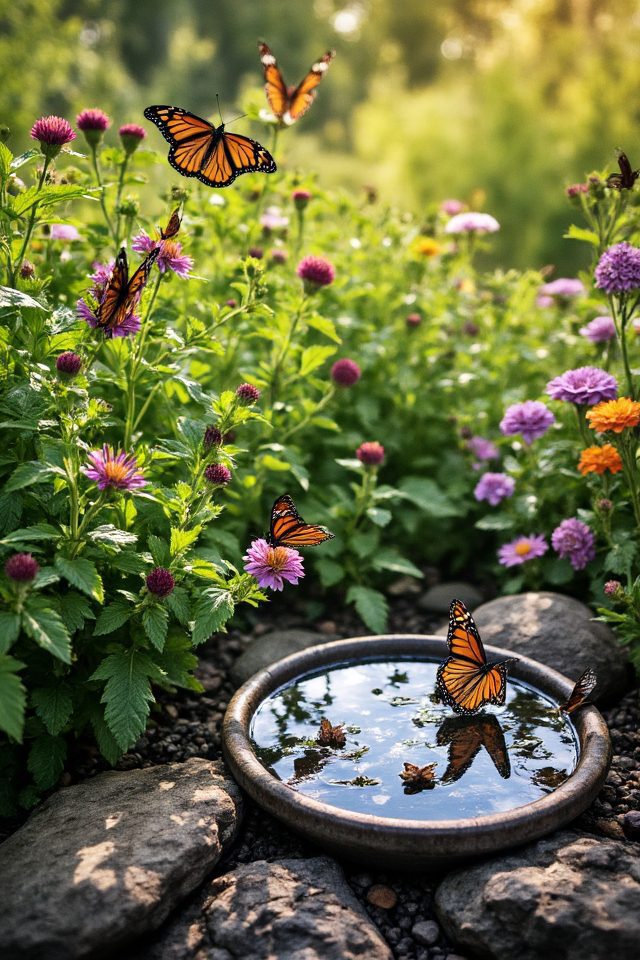
Creating a butterfly garden is a delightful way to attract and support these beautiful pollinators.
Start by selecting a variety of host plants, such as milkweed for monarchs or parsley for swallowtails, which provide nourishment for caterpillars.
Complement these with nectar-rich flowers like coneflowers, lantanas, and asters to attract adult butterflies.
Position the garden in a sunny area, and incorporate elements like flat stones for basking and shallow dishes of water to create a vibrant ecosystem that enhances your outdoor space.
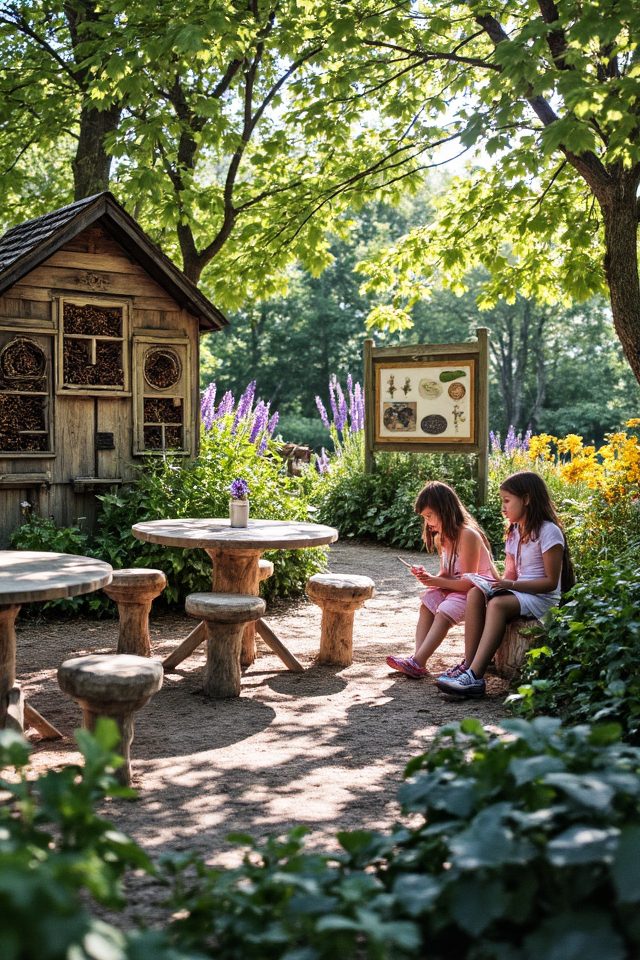
Transforming your outdoor space into a classroom can inspire a love for nature and the environment. Incorporate native plants, sensory gardens, and interactive learning stations, such as bug hotels and plant identification boards.
Include comfortable seating areas for discussions or readings about ecology. Historic park designs, like those seen in the National Park Service, encourage hands-on exploration, making learning about wildlife and ecosystems both engaging and educational.
Create a space that nurtures curiosity and connects learners to the natural world.
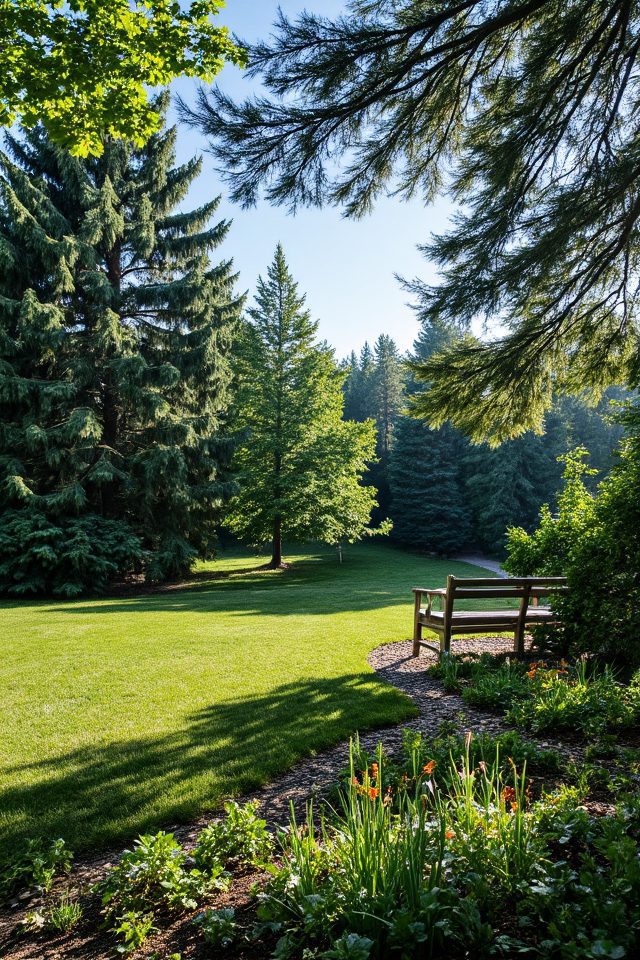
Incorporating windbreaks with dense evergreen plantings can elevate your landscape by providing both beauty and functionality.
These hearty trees form a natural barrier against harsh winds, reducing erosion and enhancing microclimates in your garden. Choose a mix of species, such as spruces, firs, or pines, to create varied textures and colors throughout the seasons.
Not only do these evergreen windbreaks protect your plants, but they also offer year-round privacy and a serene backdrop reminiscent of America’s lush parks.
By embracing these 20 landscaping ideas inspired by America’s parks, you’re not just transforming your outdoor space; you’re creating a haven for wildlife and a sanctuary for yourself. Each choice you make, from planting native species to crafting tranquil water features, contributes to a vibrant, sustainable environment. Celebrate National Public Lands Day by nurturing the beauty around you and fostering a connection with the natural world. Your garden can inspire others and become a part of the legacy of our treasured public lands.

Don't let aphids, slugs, and caterpillars ruin another plant. Take back control with simple, natural methods that actually work.